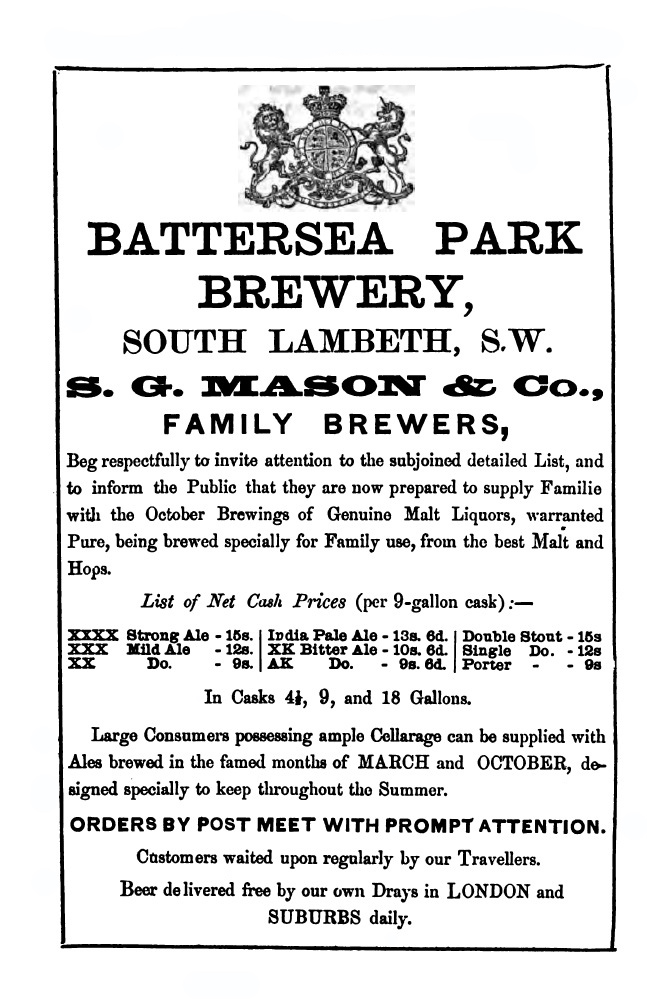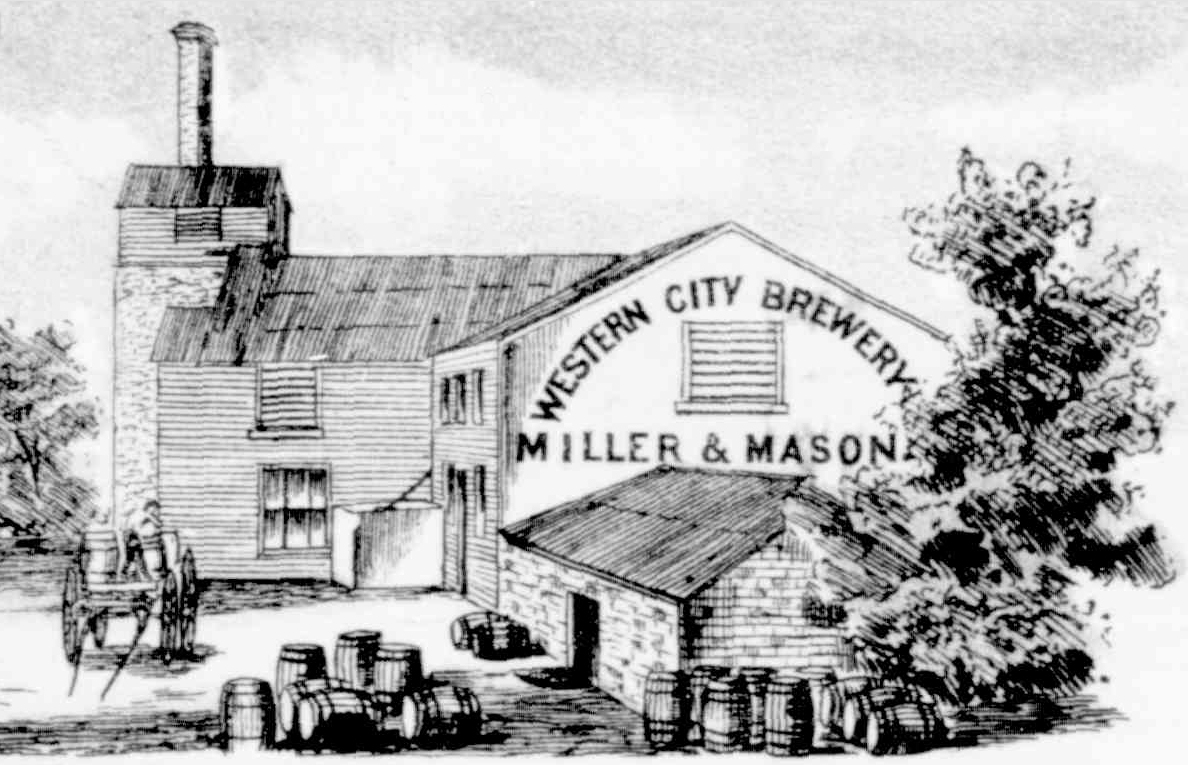
A Brewing Life: Samuel George Mason (1851–1910)

An advertisement for Samuel Mason’s Battersea Park Brewery, South Lambeth, from early 1872.
Samuel George Mason was one of many English brewers who came to the Australian colonies in the nineteenth century to practise their craft and contribute to the development of our own nascent brewing industry. His father being the co-owner of a brewery in England, it can be said that Mason was born into the beer business, but his brewing career was mostly carried on independently of his family, and mostly in far distant Victoria and New South Wales.
Details of Mason’s birth are not altogether clear, but it probably occurred in Dorchester, Dorset, in 1851. About that time his father, Alfred Samuel Mason, a brewer, became a partner in a brewing firm at Dorchester, which traded from that time as Eldridge, Mason and Co. Mason senior retired and sold his share of the business early in 1871. Samuel then was about nineteen years of age and still a ‘scholar’, and it seems fair to assume that he was then undergoing training as a brewer, possibly at his father’s establishment in Dorchester.
The Mason family left Dorset in 1871 and went to live in London. There Samuel took over the operation of the existing Battersea Park Brewery in South Lambeth, which he ran under the name of S. G. Mason and Co. and in which he had probably been installed by his father, cashed up from the sale of his share in the brewery at Dorchester. It is supposed that Alfred also played some role in the running of his young son’s first brewery.
After about four years at South Lambeth, Samuel quit his business there and sailed for the rising Antipodean colony of Victoria. He arrived in Melbourne in November 1875 on the new iron clipper ship Melbourne after a passage of two months, and obtained a position almost immediately at George Hunter’s Kent Brewery at Bendigo, one of about nine breweries then in operation at the bustling gold-mining town.
Hunter began advertising in early December 1875 that he had engaged the services of Mason, and was able to supply ales produced by the ‘well-known London brewer’. The speed with which Mason became settled at the Kent Brewery makes it seem likely that he had come to Victoria specifically to work for Hunter, else his arrival coincided exactly and fortuitously with Hunter’s desire to hire a brewer.
The appointment soon paid dividends for Hunter, as Mason’s first brew in the colony secured the gold medal at the Bendigo Agricultural and Horticultural Society’s autumn show in 1876. Another of the brewery’s products was awarded a silver medal at the same show. Hunter decided to present the prizes to Mason, who in turn decided to have them combined together in the form of a locket. This was expertly fashioned by the Bendigo jeweller John Melrose, and bore on one side the inscription ‘Awarded to S. G. Mason, brewer of the Kent Brewery Company, for having obtained the special prize for his Golden Hop Ale, March 29th, 1876.’
Golden Hop Ale, Mason’s own creation, was equivalent to the A. K. Bitter Ale that he had produced formerly at his brewery in London. The initials A. K. were widely applied in nineteenth century England to a light, bitter style of ale, although the actual meaning of the initials is a matter of some debate (see, for example, here then here). The local Bendigo newspaper described Mason’s version as a ‘light ale, of fine golden color…well suited for an agreeable summer drink’.
Success came again to the Kent Brewery at the autumn show in 1877, with first prizes for bottled and draught porter, a first prize for bottled ale, and a second prize for draught ale. Again the proprietor allowed his brewer to receive the honours, and again Mason determined to have the prizes combined. Melrose fashioned the gold and silver for the four medals into an ornate cross bearing, among other things, the inscription ‘Awarded to S. G. Mason, brewer, Kent Brewery’.
Mason remained at the Kent Brewery for ten years, until early 1886 when he and his younger colleague George Alexander Miller together took over the running of the Western City Brewery at Hamilton, in Victoria’s far south-western corner. The employees of the Kent Brewery presented the highly respected duo with inscribed gold lockets at a gathering to mark their departure from Bendigo.
After two years at Hamilton, Miller and Mason decided to try their luck in Sydney, purchasing a small brewery in Harris Street, Ultimo, that had operated under a few different names and proprietorships since its establishment in 1885. Mason went to Sydney in August 1888 to take control of their new acquisition, but Miller remained in Hamilton until early 1889, after new owners had taken possession of and settled into the Western City Brewery. The pair continued their Sydney brewery under its previous name, the Red Heart Brewery.
Strong ale brewed by Mason at Hamilton was awarded at the Centennial International Exhibition in Melbourne in October 1888, and that fact was exploited by Miller and Mason to publicise their new venture in Sydney. They later gave it a new name, adopting the title Anglo-Australian Brewery to reflect their own origins; Mason was English-born, but Miller was a native-born Victorian.

Miller and Mason’s Western City Brewery, Hamilton, Victoria, in 1888
Starting a new brewery in Sydney in 1888 was a bold move for anyone, even an experienced and awarded brewer like Mason. Three other breweries were started in the city that year, several had arisen since the beginning of the decade, and altogether more than a dozen were in operation in Sydney in 1888. Competition was fierce, and Miller and Mason decided early in 1890 to withdraw from the field, terminate their partnership of four years, and instead to pursue independent brewing careers. They were the last brewers to occupy the Harris Street premises.
George Miller soon took up a position as the manager of a brewery at Hay in western New South Wales, while Samuel Mason became the head brewer for the Albury Brewing and Malting Company Limited at the Murray River town of Albury. Mason remained at Albury for eight years, leaving in January 1898 to occupy the corresponding position with a much larger concern, the Castlemaine Brewery and Wood Brothers and Co. Limited of Newcastle.
At Newcastle early in 1898, Mason successfully applied his brewing expertise to the eradication of an infection problem that had bedevilled the company for more than a year, which had caused it a costly loss of business, and which had defeated his two predecessors. Mason remained with the Castlemaine Brewery for nearly thirteen years, until his death brought his brewing career to an unexpected and premature end in December 1910. More can be discovered about Mason’s time at Newcastle in my recently published (2016) Bygone Breweries of NSW: The Hunter River District.
Mason was interred at Sandgate Cemetery, the now sprawling necropolis beside the Pacific Highway/Maitland Road at Newcastle’s northern outskirts. His family—his wife Georgina, whom he had met in Victoria in the 1880s, and two daughters, one born in Victoria and one born in Sydney—later moved away from Newcastle. I wonder whether their descendants, if any, still possess and perhaps cherish some of the relics of Mason’s long and successful brewing career, such as the awards fashioned by Melrose in the 1870s, the gold locket presented to him by his colleagues upon his departure from Bendigo in 1886, or his prize medals from the 1888 Centennial Exhibition in Melbourne



